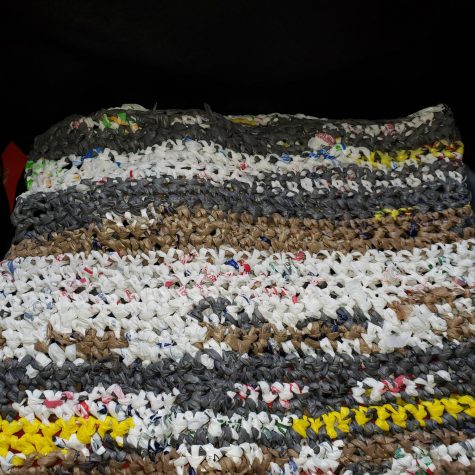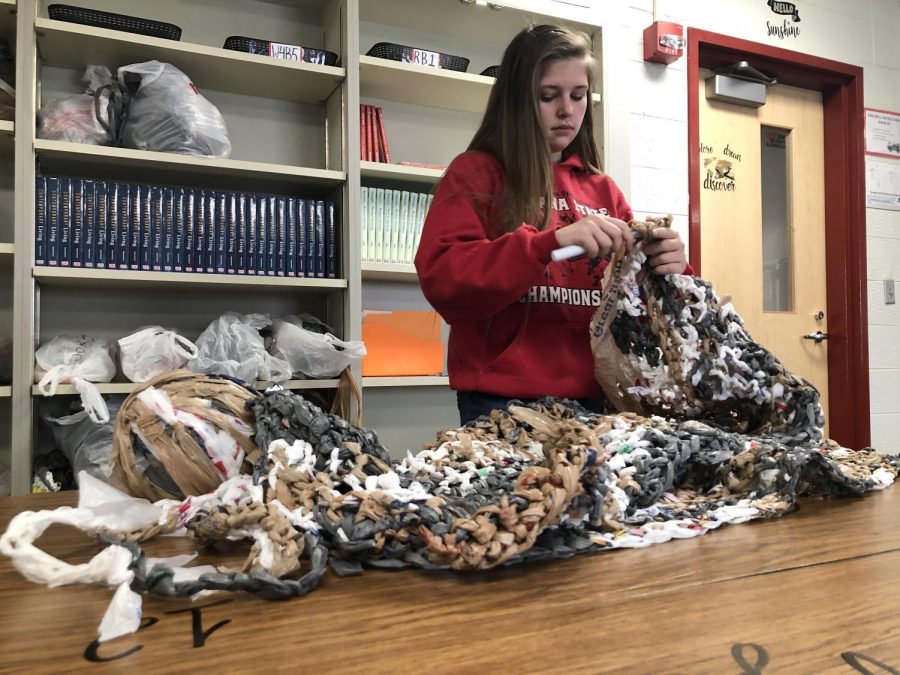Cardinals give back
Students create sleeping mats out of plastic bags to be distributed to the homeless
Senior Makayla Maxwell works on a mat. This is the Human and Social Services students’ end-of-the-semester project.
Her classroom walls lined with plastic, FACS teacher Mariette Fleck sits in the front of her classroom with a large ball of plarn, or plastic yarn, crocheting a design onto the mat laying on her desk. Students in her Human and Social Services class have begun their end-of-the-semester project, making mats that will be distributed to the homeless people around Indianapolis. This project is known as Cardinal Mercy Mats.
Cardinal Mercy Mats is a solution for plastic waste and is hoped to be beneficial to homeless people around the community. In order to get their final credit, students are required to complete a service project, and Cardinal Mercy Mats is the one this class has taken on. Students work individually on their mats.
“We’re all excited to be able to give back to the community,” senior Makayla Maxwell said. “It’s something fun and easy.”
According to junior Keyshon Reed, students in the class have bonded over giving back to their community, and they enjoy working on such a challenging project. He says he is thankful to be making something by hand to help others in need. He hopes that their project will make an impact on someone’s life and the environment in general.
“We just wanted to help and try to change the community in a way that we could,” Reed said. “It also helps with recycling and the environment. It was like knocking out two things.”
This is not the only class taught by Fleck that has volunteered to help in the process of making the mats. Students in Fleck’s Interpersonal Relationships class help to make plarn. Plastic bags are cut into strips, tied and rolled together to make plarn, which is then used to create the mats.

The completed mats will be distributed to homeless people around Indianapolis at the end of the semester.
From there, the crocheting of the mats begins. According to Maxwell, crocheting the plastic together is a lot harder than it looks. Using plarn to crochet 3’x6′ mats, the students use crocheting hooks to put the plarn strips together, or they make other various designs with their hands. Each mat requires a lot of time because of how long they have to be — as long as a grown man — and the quality with which they have to be produced.
“I’m still in the process of doing one,” Reed said. “I would never have thought that crocheting would be this hard, but it is.”
Plastic bags allow the mats to be lightweight and easy to carry around, as many homeless people often sleep in different spots each night. Making mats can take as long as two weeks, so students usually take their mats home to complete.
“At first, I didn’t think it was going to work out because it didn’t make sense in my head,” Maxwell said. “Plastic bags, how is that going to work out? Then we started doing it, and I realized it’s actually a really good idea, and (the mats would) survive a lot of weather conditions.”
Fleck is welcoming any contributions that the class can take from students that are willing to help. Although other classes, such as art classes, have tried the project too, she says the Human and Social Services classes have the right number of students and class periods to successfully do it. According to Fleck, by the end of this semester, her goal is for her class to be able to provide as many as 50 Cardinal Mercy Mats to give to homeless people around the area by the end of the semester.
“The Cardinal Mercy Mats are an excellent way for students to give back,” Fleck wrote in an email to The Journal. “Not only are they making sleep mats for the homeless, but they are also recycling plastic bags.”

Hey guys, welcome back to my channel! Well not really, but welcome to my last bio for The Journal. Hi, I’m Tanny Khun and this year I will be taking...







